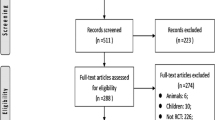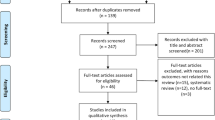Abstract
Background
Hip fractures are associated with high morbidity, mortality, and cost. Implants used for hip fracture fixation can fail for many reasons including lag screw cut-out. Tip–apex distance (TAD) is indicative of the position and depth of a screw in the femoral head and has been shown to be associated with cut-out failure. We conducted a systematic review of the published literature to quantify the association between TAD and cut-out failure for patients undergoing hip fracture fixation surgery.
Methods
We performed a search of the Medline, Embase, and Cochrane databases. We performed abstract and full text reviews independently and in duplicate. We used a random effects model to combine, in duplicate, the incidence of cut-out for patients who had TAD <25 mm and TAD >25 mm. We also combined mean TAD values for patients who had cut-out failure and those who did not.
Results
Seventeen studies were eligible for this review, four of which were included in combined analysis of dichotomous outcomes and seven in combined analysis of continuous outcomes. Patients with TAD >25 mm had a significantly greater risk of cut-out than patients with TAD <25 mm (RR = 12.71). Patients who experienced implant cut-out had significantly higher TAD scores than those who did not (mean difference = 6.54 mm).
Conclusion
Tip–apex distance is an important concept in relation to cut-out failure of hip fracture fixation surgery. Surgeons should understand and apply the concept of TAD to improve outcomes for their patients.




Similar content being viewed by others
References
Keene G, Parker M, Pryor G. Mortality and morbidity after hip fractures. BMJ. 1993;307:1248–50.
Brandt SE, Lefever S, Janzing HMJ, Broos PLO, Pilot P, Houben BJ. Percutaneous compression plating (PCCP) versus the dynamic hip screw for pertrochanteric hip fractures: preliminary results. Injury. 2002;33:413–8.
Johnell O, Kanis JA. An estimate of the worldwide prevalence, mortality and disability associated with hip fracture. Osteoporos Int. 2004;15:897–902 (Epub 2004).
Centers for Disease Control and Prevention. Hip Fractures Among Older Adults [Internet]. Atlanta (GA): USA.gov; [2010; cited 2010]. http://www.cdc.gov/homeandrecreationalsafety/falls/adulthipfx.html.
Braithwaite R, Col N, Wong J. Estimating hip fracture morbidity, mortality, and costs. J Am Geriatr Soc. 2003;51:364–70.
Autier P, Haentjens J, Bentin J, Baillon JM, Grivegnee AR, Closon MC, Boonen S. Costs induced by hip fractures: a prospective controlled study in Belgium. Osteoporos Int. 2000;11:373–80.
Lenich A, Vester H, Nerlich M, Mayr E, Stöckle U, Füchtmeier B. Clinical comparison of the second and third generation of intramedullary devices for trochanteric fractures of the hip—blade vs screw. Injury. 2010;41:1292–6.
Baumgaertner MR, Solberg BD. Awareness of tip–apex distance reduces failure of fixation of trochanteric fractures of the hip. JBJS. 1997;79:969–71.
Baumgaertner MR, Curtin SL, Lindskog DM, Keggi JM. The value of the tip–apex distance in predicting failure of fixation of peritrochanteric fractures of the hip. J Bone Joint Surg Am. 1995;77:1058–64.
Parmar V, Kumar A. The importance of surgical education in the accuracy of implant placement during hip fracture fixation. J Orthop Traumatol. 2009;10:59–61.
Güven M, Yavuz U, Kadioğlu B, Akman B, Kilinçoğlu V, Unay K, Altintaş F. Importance of screw position in intertrochanteric femoral fractures treated by dynamic hip screw. Orthop Traumatol Surg Res. 2010;96:21–7.
Stern R, Lübbeke A, Suva D, Miozzari H, Hoffmeyer P. Prospective randomised study comparing screw versus helical blade in the treatment of low-energy trochanteric fractures. Int Orthop. 2011;35:1855–61 (Epub 2011).
DerSimonian R, Laird N. Meta-analysis in clinical trials. Control Clin Trials. 1986;7:177–88.
Geller JA, Saifi C, Morrison TA, Macaulay W. Tip–apex distance of intramedullary devices as a predictor of cut-out failure in the treatment of peritrochanteric elderly hip fractures. Int Orthop. 2010;34:719–22.
Hsueh KK, Fang CK, Chen CM, Su YP, Wu HF, Chiu FY. Risk factors in cutout of sliding hip screw in intertrochanteric fractures: an evaluation of 937 patients. Int Orthop. 2010;34:1273–6 (Epub 2009).
De Bruijn K, den Hartog D, Tuinebreijer W, Roukema G. Reliability of Predictors for Screw Cut-out in Intertrochanteric Hip Fractures. J Bone Joint Surg Am. 2012;94:1266–72.
Andruszkow H, Frink M, Frömke C, Matityahu A, Zeckey C, Mommsen P, Suntardjo S, Krettek C, Hildebrand F. Tip apex distance, hip screw placement, and neck shaft angle as potential risk factors for cut-out failure of hip screws after surgical treatment of intertrochanteric fractures. Int Orthop. 2012;36:2347–54. doi:10.1007/s00264-012-1636-0 (Epub 2012).
Schmidt-Rohlfing B, Heussen N, Knobe M, Pfeifer R, Kaneshige JR, Pape HC. Re-operation rate after internal fixation of intertrochanteric femur fractures with the Percutaneous Compression Plate (PCCP): what are the risk factors? J Orthop Trauma. 2012 (Epub ahead of print).
Herman A, Landau Y, Gutman G, Ougortsin V, Chechick A, Shazar N. Radiological evaluation of intertrochanteric fracture fixation by the proximal femoral nail. Injury. 2012;43:856–63 (Epub 2011).
Lobo-Escolar A, Joven E, Iglesias D, Herrera A. Predictive factors for cutting-out in femoral intramedullary nailing. Injury. 2010;41:1312–6 (Epub 2010).
Kyle RF, Ellis TJ, Templeman DC. Surgical treatment of intertrochanteric hip fractures with associated femoral neck fractures using a sliding hip screw. J Orthop Trauma. 2005;19:1–4.
Pervez H, Parker MJ, Vowler S. Prediction of fixation failure after sliding hip screw fixation. Injury. 2004;35:994–8.
Brammar TJ, Kendrew J, Khan RJ, Parker MJ. Reverse obliquity and transverse fractures of the trochanteric region of the femur; a review of 101 cases. Injury. 2005;36:851–7 (Epub 2005).
Inglis MRB, Jaarsma RL. Intramedullary hip screw fixation of reverse oblique and transverse trochanteric femur fractures. Eur J Orthop Surg Traumatol. 2008;18:323–6.
Holt G, Nunag P, Duncan K, Gregori A. Outcome after short intramedullary nail fixation of unstable proximal femoral fractures. Acta Orthop Belg. 2010;76:347–55.
Wu CC, Tai CL. Effect of lag-screw positions on modes of fixation failure in elderly patients with unstable intertrochanteric fractures of the femur. J Orthop Surg (Hong Kong). 2010;18:158–65.
Heineman DJ, van Buijtenen JM, Heuff G, Derksen EJ, Po RG. Intra-abdominal migration of a lag screw in gamma nailing: report of a case. J Orthop Trauma. 2010;24:e119–22.
Frank MA, Yoon RS, Yalamanchili P, Choung EW, Liporace FA. Forward progression of the helical blade into the pelvis after repair with the trochanter fixation nail (TFN). J Orthop Trauma. 2011;25:e100–3.
Lenich A, Bachmeier S, Dendorfer S, Mayr E, Nerlich M, Füchtmeier B. Development of a test system to analyze different hip fracture osteosyntheses under simulated walking. Biomed Tech (Berl). 2012;57:113–9. doi:10.1515/bmt-2011-0999.
Acknowledgments
The authors would like to acknowledge Alice Chen and Sahaana Rangarajan for their assistance with administrative tasks.
Conflict of interest
The authors declare that they have no conflict of interest.
Author information
Authors and Affiliations
Corresponding author
About this article
Cite this article
Rubio-Avila, J., Madden, K., Simunovic, N. et al. Tip to apex distance in femoral intertrochanteric fractures: a systematic review. J Orthop Sci 18, 592–598 (2013). https://doi.org/10.1007/s00776-013-0402-5
Received:
Accepted:
Published:
Issue Date:
DOI: https://doi.org/10.1007/s00776-013-0402-5




